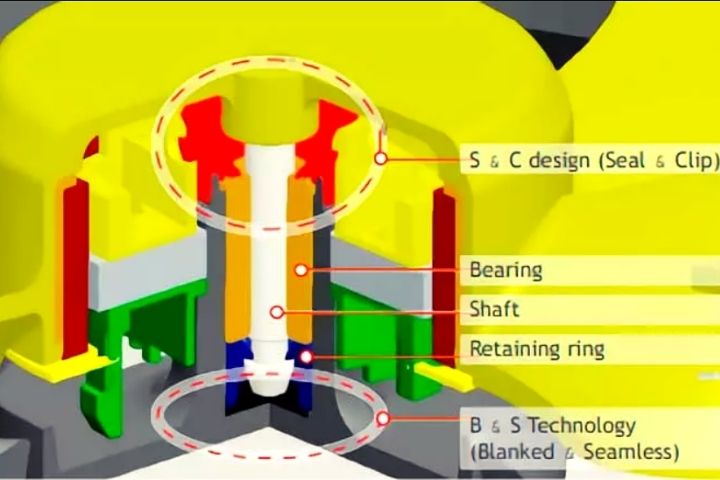Magnetic levitation fans are one of the simplest, most efficient and cost-effective options for cooling PC components. They quickly cool down your CPU when you’re playing games or rendering videos. This is how they work!
Magnetic levitation fans are a new technology that makes fan operation more efficient and energy-saving. They use less power, noiselessly enough to allow for sleep or concentration in spaces like offices or libraries. Here’s how they work!In a world where everything is electronic, it’s hard to imagine something that’s not. But even though magnetic levitation fans are still rare among PC gamers, they’re starting to become more common as the technology becomes cheaper and easier for manufacturers to produce. On its own it might be an interesting piece of hardware but without all the hype surrounding VR or AR headsets, these devices have a lot of potential in pioneering another area of digital immersion.,
Sunon’s “maglev” is a magnetic levitation fan that uses the principle of electromagnetic induction to lift objects. The fans run on a single power supply and can be installed anywhere in the room.
PC fans are both important and troublesome, since they do not weather the passage of time well, resulting in a slew of issues. If we’re talking about fans that cost a few euros, replacing a broken one with a new one isn’t a big deal, but a luxury fan that costs five times as much… It’s excruciating. Not to mention the noise and traffic congestion they face, which is why manufacturers developed magnetic levitation devices after decades of research and development. But how do they work?
When it comes to time and wear, all common fans suffer from the same issues, whether to a greater or smaller degree, straight out of the box and newly purchased. Friction, noise, and calibration flaws, among other things, make some models’ experience and performance a misery.
Fans of PCs, a never-ending cycle of R&D
The difficulty with any conventional fan is the actual wear on the shaft and rotor, which occurs both within and outside the fan. In the early PC models, reliability was prioritized above loudness or performance; in other words, the fan should not fail. This raised the product’s price, but many of us willingly paid the higher price.
There were no aesthetics, lights, or anything like that; just a basic injection ABS plastic fan in black with three pins for control and, in the best of circumstances, RPM readout, and a 12 volt molex connection.
Anyone who bought premium fans in the 1980s and 1990s knows how long they lasted, but it wasn’t quite as long as it is today. In most versions, the bearings were not FDB, and maintenance was required every few months owing to friction and microparticles.
These caused unpleasant sounds and oscillations in the fan, which caused the shaft and blades to protrude from the frame when seen from the edge. So, what’s the solution? Everything improved when the hard drive industry’s direct fluid bearings and most modern turntable technologies appeared. The metallic noise was reduced to a much more acceptable level, the system’s durability increased, and fluid directing channels were added to redirect fluid and enhance the temperature and friction of the walls and rotor.
There have been major advancements since then, but none have really addressed the issue until the arrival of magnetic levitation fans.
The Ultimate Solution: Magnetic Levitation Fans
Going through all of the current bearing subtypes, from the so-called Sleeve Bearing to the Ball Bearing, none of them can address the challenges caused by the fan’s high torsional stiffness or anchoring. Why? Mostly because of the fans’ magnetic and conventional rotor systems, in other words, because of their design and execution.
In a standard fan, the stator is positioned such that the magnetic edge integrated into the body of the fan blades keeps the center of gravity horizontal. Logic dictates that gravity has an influence, no matter how little, and that even if the stator has four motors surrounding the rotor, this generates blind patches of magnetism between them, implying a very tiny axis deviation, whether the fan is horizontal or vertical.
To this must be added the rotor’s degradation due to contact with another body, even when lubricated, which results in everything working correctly at the start of the fan’s useful life, but the fan becomes off center over time and use, and the only way to repair it is to replace the entire rotor with its washers, liquid or oil or compound.
Magnetic levitation in PC fans avoids this since the magnetic field’s center of gravity is vertically positioned by one or more magnetic magnets, ensuring that the fan is completely calibrated at all times. This permits the rotor to be perfectly aligned and to experience the same “wear” everywhere symmetrically, resulting in the least amount of friction and, as a result, the least amount of noise (there is no wear beyond contact with the air).
Furthermore, magnetic levitation systems, in general, prevent dust from accumulating on the motor’s walls, and, as if that weren’t enough, because there is less friction and more stability in the rotor, the temperature generated is lower, resulting in less expansion between the parts and thus greater overall durability.
Neutralization of Engine Deadweight
Another factor to consider is that since the push and attraction between the magnets is vertical, an attraction in the same direction is created, allowing the impeller rotor to reach the shaft’s end. Even if the fan is positioned vertically, the distance is so tiny and the adjustment so precise that the weight of the rotor itself, with the motor and blades, is completely neutralized.
As a result, the shaft spins freely without being influenced by gravity, which enhances all of the preceding points. In other words, the bearing and shaft maintain a constant distance in time without really touching, rotating in an orbit that is, if not perfect, almost perfect, which removes any vibration caused by rotation since there is no physical contact at any point.
As a result, we’re dealing with a system that directly eliminates noise from the rotor and motor, leaving everything to the fluid aerodynamics of the blades, the fan frame, or the number of revolutions it can achieve in turn, since there will be a noticeable difference in performance and loudness between fans.
Because it is focused on either high performance fans or great durability at low RPM and 24/7 operation, this system is relatively new, and only a few organizations have dared to employ it owing to the high expenses involved. As a result, they are costly, and the typical user is unlikely to invest 20 or 30 euros per unit, but in the long term, they provide a guarantee of performance and piece of mind.
Sunon maglev fan disassembly is a blog that explains how the magnetic levitation fans work. This is a great blog for people who are interested in learning more about how these types of fans work. Reference: sunon maglev fan disassembly.
{“@context”:”https://schema.org”,”@type”:”FAQPage”,”mainEntity”:[{“@type”:”Question”,”name”:”How does magnetic levitation fans work?”,”acceptedAnswer”:{“@type”:”Answer”,”text”:”A: The air is cooled by a large metal plate, which has magnets attached to it. When the fan spins around in a circle, these magnets cause an upward force on the blades of the fan that actually lifts them off of the ground and causes them to spin faster than they would with gravity alone.”}},{“@type”:”Question”,”name”:”How long do magnetic levitation fans last?”,”acceptedAnswer”:{“@type”:”Answer”,”text”:””}},{“@type”:”Question”,”name”:”How do Corsair maglev fans work?”,”acceptedAnswer”:{“@type”:”Answer”,”text”:”A: Magnetic levitation uses the Lorentz force to suspend objects 10,000 times lighter than air in an electrostatic field. The heavier object is brought up by gently pushing it against the magnetic field; when this happens, a strong repulsive force (opposite of attraction) results due to static electricity.”}}]}
Frequently Asked Questions
How does magnetic levitation fans work?
A: The air is cooled by a large metal plate, which has magnets attached to it. When the fan spins around in a circle, these magnets cause an upward force on the blades of the fan that actually lifts them off of the ground and causes them to spin faster than they would with gravity alone.
How long do magnetic levitation fans last?
How do Corsair maglev fans work?
A: Magnetic levitation uses the Lorentz force to suspend objects 10,000 times lighter than air in an electrostatic field. The heavier object is brought up by gently pushing it against the magnetic field; when this happens, a strong repulsive force (opposite of attraction) results due to static electricity.
Related Tags
- sunon maglev fan noise
- magnetic levitation fans vs normal
- are magnetic levitation fans good
- magnetic levitation fans reddit
- magnetic pc fans

